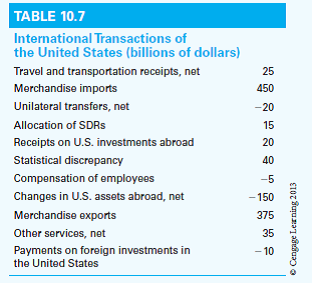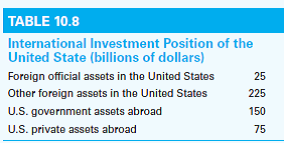Deck 10: The Balance of Payments
Question
Question
Question
Question
Question
Question
Question
Question
Question
Question
Question

Unlock Deck
Sign up to unlock the cards in this deck!
Unlock Deck
Unlock Deck
1/11
Play
Full screen (f)
Deck 10: The Balance of Payments
1
What is meant by the balance of payments?
The balance of payments of a country is a record of all its economic transactions with the countries in the rest of the world. This record is typically maintained over the course of one year. Entries in the balance of payments are either credited (inflow of money) or debited (outflow of money) and this record keeps track of a nation's spending, whether it is overspending or having a surplus of income.
2
What economic transactions give rise to the receipt of dollars from foreigners? What transactions give rise to payments to foreigners?
An economic transaction that gives rise to the receipt of dollars from foreigners is called a credit transaction. An economic transaction that leads to a payment to foreigners is called a debit transaction. Suppose the United States exports products to China. This results in a receipt of dollars from the Chinese because they are paying money to purchase the exports from Americans. This is an example of a credit transaction in which there is an inflow of income into the country. In contrast when the U.S. imports goods from China, it is paying money to import the Chinese goods. This is an example of a debit transaction in which there is an outflow of income from the country.
3
Why does the balance-of-payments statement "balance"?
The balance of payments is a statement consisting of a nation's economic transactions with all other nations for a given year. The statement always balances because it follows a double-entry accounting system, where total debits (payments) will always equal total credits (receipts). In a small-scale example, one person's purchase of a good will result in another person's income from the sale of that good. Likewise, this applies to the transactions between nations. This explains why the balance-of-payments statement always "balances."
4
From a functional viewpoint, a nation's balance- of-payments can be grouped into several categories. What are these categories?

Unlock Deck
Unlock for access to all 11 flashcards in this deck.
Unlock Deck
k this deck
5
What financial assets are categorized as official reserve assets for the United States?

Unlock Deck
Unlock for access to all 11 flashcards in this deck.
Unlock Deck
k this deck
6
What is the meaning of a surplus (deficit) on the (a) merchandise trade balance, (b) goods and services balance, and (c) current account balance?

Unlock Deck
Unlock for access to all 11 flashcards in this deck.
Unlock Deck
k this deck
7
Why has the goods and services balance sometimes shown a surplus while the merchandise trade balance shows a deficit?

Unlock Deck
Unlock for access to all 11 flashcards in this deck.
Unlock Deck
k this deck
8
What does the balance of international indebtedness measure? How does this statement differ from the balance-of-payments?

Unlock Deck
Unlock for access to all 11 flashcards in this deck.
Unlock Deck
k this deck
9
Indicate whether each of the following items represents a debit or a credit on the U.S. balance-of-payments:
a. A U.S. importer purchases a shipload of French wine.
b. A Japanese automobile firm builds an assembly plant in Kentucky.
c. A British manufacturer exports machinery to Taiwan on a U.S. vessel.
d. A U.S. college student spends a year studying in Switzerland.
e. American charities donate food to people in drought-plagued Africa.
f. Japanese investors collect interest income on their holdings of U.S. government securities.
g. A German resident sends money to her relatives in the United States.
h. Lloyds of London sells an insurance policy to a U.S. business firm.
i. A Swiss resident receives dividends on her IBM stock.
a. A U.S. importer purchases a shipload of French wine.
b. A Japanese automobile firm builds an assembly plant in Kentucky.
c. A British manufacturer exports machinery to Taiwan on a U.S. vessel.
d. A U.S. college student spends a year studying in Switzerland.
e. American charities donate food to people in drought-plagued Africa.
f. Japanese investors collect interest income on their holdings of U.S. government securities.
g. A German resident sends money to her relatives in the United States.
h. Lloyds of London sells an insurance policy to a U.S. business firm.
i. A Swiss resident receives dividends on her IBM stock.

Unlock Deck
Unlock for access to all 11 flashcards in this deck.
Unlock Deck
k this deck
10
Table 10.7 summarizes hypothetical transactions, in billions of U.S. dollars, that took place during a given year.
a. Calculate the U.S. merchandise trade, services, goods and services, income, unilateral transfers, and current account balances.
b. Which of these balances pertains to the net foreign investment position of the United States? How would you describe that position?
a. Calculate the U.S. merchandise trade, services, goods and services, income, unilateral transfers, and current account balances.
b. Which of these balances pertains to the net foreign investment position of the United States? How would you describe that position?


Unlock Deck
Unlock for access to all 11 flashcards in this deck.
Unlock Deck
k this deck
11
Given the hypothetical items shown in Table 10.8, determine the international investment position of the United States. Is the United States a net-creditor nation or a net-debtor nation? 


Unlock Deck
Unlock for access to all 11 flashcards in this deck.
Unlock Deck
k this deck



